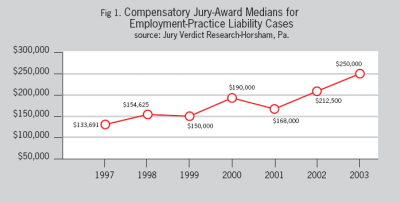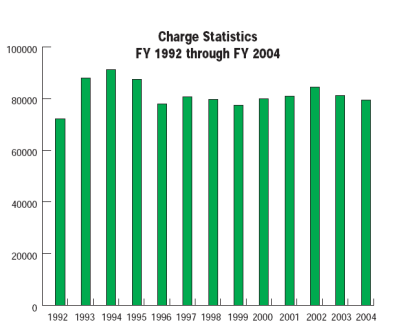Wal-Mart, Morgan Stanley, Boeing, Texaco, State Farm and Farmers have all been the targets of recent employment practices lawsuits. Wal-Mart was hit with sexual harassment charges. Farmers was sued for wrongful termination. Morgan Stanley and State Farm allegedly engaged in gender discrimination, while Boeing and Texaco have been accused of race discrimination. These high-profile lawsuits have made headlines with their multi-million dollar settlements, but they merely highlight a growing trend of employees suing employers.
About 550 employment practices lawsuits are filed in the United States every day, according to Lucy Ann Galioto, vice president of National Union Fire Insurance Company of Pittsburgh, Pa., a surplus lines carrier with a specialty in professional liability and a member company of American International Group. “I think if your company engages in hiring, maintaining and firing employees, you really should look at employment practices liability insurance,” Galioto said.
The need for employment practices liability insurance is greater than ever before, but many employers do not know that they are at risk. Agents and brokers may not realize that failing to educate a client about this type of insurance may make them more vulnerable from an errors & omissions standpoint. It is in every producer's best interest to understand the risks associated with the EPLI market.

Claims increase in frequency and severity
Overall, employment practices claims seem to be increasing in terms of severity but may be decreasing in frequency. According to the U.S. Equal Employment Opportunity Commission, the number of employment practice charges filed with the federal agency is on the decline.
In 2002, total charges filed were 84,442 while 2003 saw only 81,293 filings. In 2004, the number of individual complaints made by employees was down at 79,432 (see “Charge Statistics,” page N8). But according to a 2004 report by Horsham, Pa.-based Jury Verdict Research, the median jury compensatory award for employment-practice cases has increased over the last two years, and currently stands at $250,000 (see Figure 1, page N7). The same award for 2001 was $168,000.

“The number of filings have pretty much leveled off, pretty much stabilized, and in some cases they've even gone down,” said Richard Clarke, vice president of Atlanta, Ga.-based J. Smith Lanier & Co. “But the monetary benefits, the total sums that are paid by employers to settle those allegations really shows a fairly consistent increase from the early 1990s on, from about 1993 or 1994 to the present.”
Chris Christian, senior vice president of London American General Agency in San Diego, agreed that the severity of employment claims is on the rise and blamed higher defense costs and larger settlements.
“General cost for a suit that doesn't have any teeth in it is $30,000 to $40,000 to make it go away,” she said. “The severity is creeping up. It just takes a couple of landmark cases and large settlements and then the defense attorneys are more concerned and the insurance carriers are more concerned about going to trial. They're afraid they might get one of those big verdicts so they tend to settle more and the plaintiff's bar is aware of that so they ask for larger settlements.”
Michael Donnelly, vice president of Austin, Texas-based wholesale broker Professional Lines Underwriting Specialists Inc. (PLUS), said that it is often difficult for defendants to win. “[Plaintiff's lawyers] have done an excellent job of really putting their client in the position to win these cases at trial or getting it settled so that it's favorable with the amount of money that they receive for their client,” he said.
According to Henry Lopez, marketing executive at Deerfield, Ill.-based professional liability wholesaler Shand, Morahan and Co., a division of specialty insurer Markel Corp., plaintiffs recover damages in employment practices cases 75 percent of the time. In 1990, the likelihood of plaintiffs recovering damages in EPL cases was only 35 percent. Donnelly said that this increase can partially be attributed to laws passed in the 1990s, including the Title VII Amendment that allowed jury trials and the recovery of punitive damages in EPL cases.
“Over the last 15 years, the laws have continued to change to where it's almost more favorable for the plaintiff,” Donnelly said. “The federal laws that have been around starting from the '60s and amended in the early '90s have continually been expanded by the way juries have ruled in the favor of plaintiffs.”
Despite the decline in filings with the EEOC, other experts said that employment practice filings are increasing, just not at the federal level.
“EPL claims are increasing as far as their frequency. If you look at EEOC statistics, it looks like the filings are down for 2004 over 2003 but that decrease only points to the fact that there's an increase in the state filings,” Galioto said. “More employees are filing with state agencies because there's no cap on punitive damages.”
Donnelly explained that the upswing in claims frequency is a result of more public awareness of EPL claims. “There's definitely an increase in the number of claims on the frequency side because there are more and more people becoming aware of their rights,” Donnelly said. “There are more and more people seeing how people are treated in other lawsuits and those with similar situations will file a suit.”
Clarke said that there are articles in the newspapers about EPL settlements on a consistent basis and thus the public is more knowledgeable about the different ways to sue an employer.
“I think the general workforce is becoming more aware of the fact that there are avenues available for them to take against their employers for either, termination, discrimination, or harassment issues and the employees are filing more claims than they have been ever before,” agreed Jane Moore, vice president of Irvine, Calif.-based Swett & Crawford's professional services group.
Most common claims
Wrongful termination, discrimination and sexual harassment are the most common employment practices claims, experts say.
London American General Agency's Christian said that she most often sees wrongful termination cases in California. “It almost always starts when somebody gets fired,” she said. “Very rarely do people bring suit when they're still employed at the place.”
But Christian said that wrongful termination claims are often accompanied by a discrimination claim. Discrimination is prohibited federally on the basis of age, race, gender, religion, national origin and disability. Among those, race discrimination is the most common allegation, according to EEOC statistics. Racial discrimination charges were filed 36.2 percent of the time in 2000, followed closely by sex discrimination at 31.5 percent.
There has been an increase in age discrimination filings, which were filed about 20 percent of the time in 2000. “We feel that the future will hold an up tick in the number of age discrimination class actions,” Galioto said. “This is because the Bureau of Labor statistics have predicted that by 2010 more than half of all the workers will be over 40.”
PLUS' Donnelly agreed. “A big swing right now is that baby boomers who are getting closer to retirement are now facing discrimination based on age,” he said. “Larger and larger numbers of people are facing this and so a company that may have had no exposure five to 10 years ago can find themselves in a really tough spot going forward.”
Discrimination based on disability is also a common claim. “One of the things that we see a lot is the Americans with Disability Act, where a business location is not necessarily compliant with federal or state statutes regarding a disabled person,” Moore said. “They find themselves to be in the midst of a suit that alleges that they have discriminated against the handicapped person because of the person's inability to access parking or elevators, restrooms, etc.”
Other new trends emerging include claims alleging pregnancy discrimination and male on male sexual harassment claims. Galioto said that over the past year, male on male sexual harassment claims rose about 14 percent.
Certain businesses may be more vulnerable to these employment practices claims. Christian said that problems occur when there is a lot of employee turnover and where part-time or transient employees are common, which creates a large potential plaintiff pool. She said that restaurants, auto dealers and construction companies are hard-to-place classes of business.
National Union Fire's Galioto added that most service businesses are particularly vulnerable to an employment practices lawsuit, especially national retail restaurant and fast food chains, because they usually have many employees scattered throughout the country and a young workforce.
Litigation hot spots
There are about 30 or 40 EPL policies out there to protect employers from the wide range of employment practices lawsuits, according to Lopez, and rates may vary by state or region depending on the amount of employment practices litigation.
“Underwriters [have] come in and talked to us about various products and we found that especially in California, the premiums are a little higher,” Swett & Crawford's Moore said. “But I think the deductibles are higher across the board in California.”
“I think that California hands down is the most employee friendly and plaintiff friendly state,” Galioto agreed. “That does have an effect on settlement value. It costs more to defend and certainly that would be a warning to every single EPL insurer.”
“Rates are definitely higher in California,” Christian said. “The retentions are significantly higher in California.”
Christian added that other litigious states besides California include New Jersey, Illinois, Texas and Florida, while Clarke cited New York. He said that rates may not always be higher in these litigious states, but there may be stricter underwriting practices in place.
“Underwriters are more cautious if there's exposure in these states,” Clarke said. “For example, if you had an organization that had equal numbers of employees in Nebraska and California, the underwriter would be less enthusiastic about the California exposure as he or she would be about the Nebraska exposure. I don't know if that means there are more attorneys or more lawsuits filed but maybe the courts and the settlements are just a little bit more liberal in those states than they are in more conservative states.”
Donnelly said that higher rates are more likely in metropolitan areas, even within states that are already considered litigious.
“Once you get into the states, it's going to be rated more by your metropolitan areas,” Donnelly said. “A state where you have a few large metro areas, those areas are going to be rated higher than the rest of the state which may be more rural, California being an example. The whole state is rated with a high risk, but Los Angeles County will even be rated higher than other areas in the state. The same would hold true for Texas, which is historically rated higher than most other states when you get into the Austin/Dallas/San Antonio/Houston areas.”
Prices to level off in 2005
Christian said she expected to see the high prices of EPLI in litigious states level off during 2005.
“We're going to start to see a wee little bit of softening in California,” she said. “The retentions are going to stay high but the pricing is going to get a little more competitive. The coverages offered have expanded since about 1997-2003. Most of those coverages have stayed relatively stable and the underwriters are not restricting coverage yet. I think they can't really get the pricing any higher and it's starting to come down a bit.”
Moore said that the market for EPL has softened a little, and that she has seen some new players come into the marketplace, but Donnelly disagreed.
“There aren't a ton of companies jumping into the marketplace,” he said. “But a lot of them have been around for awhile and I think they've figured out exactly where they need to be from a price and coverage standpoint. The rates were pretty flat in my opinion last year. There were certain increases in certain parts of the country in certain classes of business. But prices will continue to level off. The marketplace as a whole will be pretty constant over the next 12 or 18 months.”
Galioto predicted that there will be even more EPL filings than ever in the coming year. She said that there will be more class action lawsuits involving age discrimination filed and the industry will be closely watching EEOC's recent sexual harassment lawsuit against Wal-Mart.
A potential E&O exposure for agents
More employment practices lawsuits mean that there is an increasing need for agents and brokers to sell EPL coverage to their clients. Producers could even be vulnerable from an errors & omissions standpoint if they fail to suggest this important coverage or do not provide adequate EPL coverage.
“If the agent sells a relatively small limit as a solution to the problem, then absolutely the agent is exposing himself from an errors & omissions standpoint,” Clarke said. “In a society where something goes wrong, we look for somebody else to blame. If the agent hasn't sold enough EPLI or if the quality of it isn't as good as it could be, then I think it would be expected that the injured party might try to blame that upon the agent and might certainly affect the agents' E&O exposure.”
Both Donnelly and Christian recommended that agents have proof that they offered EPL coverage to their clients. Donnelly suggested that clients sign a document stating that they have rejected EPL coverage but that the agent did recommend the coverage.
Swett & Crawford's Moore said that many agents do not know much about EPLI, but must educate themselves so they reduce their E&O exposure and successfully sell the product.
“I talk to agents that feel it's something that their client wouldn't be interested in because they don't want to pay the extra premium,” Moore said. “There are a lot of agents that don't fully understand the coverage and they're reluctant to go forth and present the coverage.”
PLUS' Donnelly said that a lot of clients do not realize there is really no coverage for EPL on any of their policies. “It's been an ISO exclusion on the GL since the early '90s and it's excluded everywhere else,” he said. “It comes down to a lack of education and understanding. Part of that is the responsibility of the agent and I don't think they've done a great job themselves always of really understanding what the exposures are with EPL.”
National Union Fire's Galioto reiterated the fact that an employment practices lawsuit could seriously hurt an employer financially. “Even if you win an employment practices lawsuit, you lose because you get to pay those defense fees,” she said. “The single plaintiff action may cost you $150,000 to defend, and that's if you win. I think when our prospective insureds realize the damages and the expense involved, they think twice about getting the insurance.”
Topics Lawsuits California Texas Agencies Claims Underwriting
Was this article valuable?
Here are more articles you may enjoy.


 Trump’s Bond Insurer Tells Judge Shortfall Is ‘Inconceivable’
Trump’s Bond Insurer Tells Judge Shortfall Is ‘Inconceivable’  Aon Completes $13B Acquisition of Middle-Market Broker NFP
Aon Completes $13B Acquisition of Middle-Market Broker NFP  Investment Funds File New Suits Over Lighthouse Insurance Collapse in 2022
Investment Funds File New Suits Over Lighthouse Insurance Collapse in 2022  Jury Awards $80M to 3 Former Zurich NA Employees for Wrongful Termination
Jury Awards $80M to 3 Former Zurich NA Employees for Wrongful Termination 


